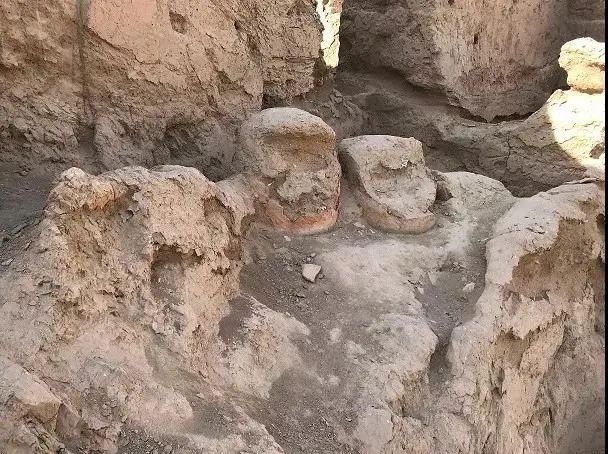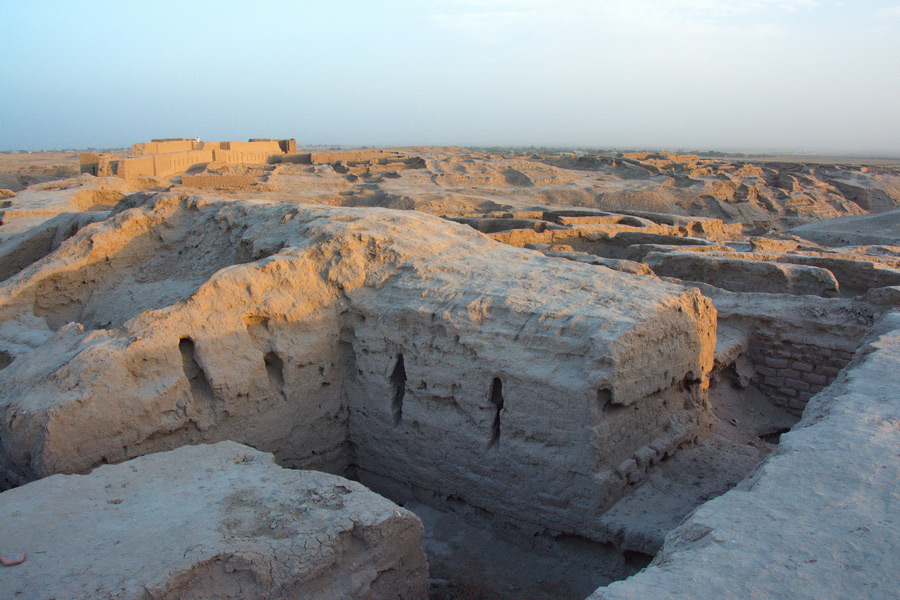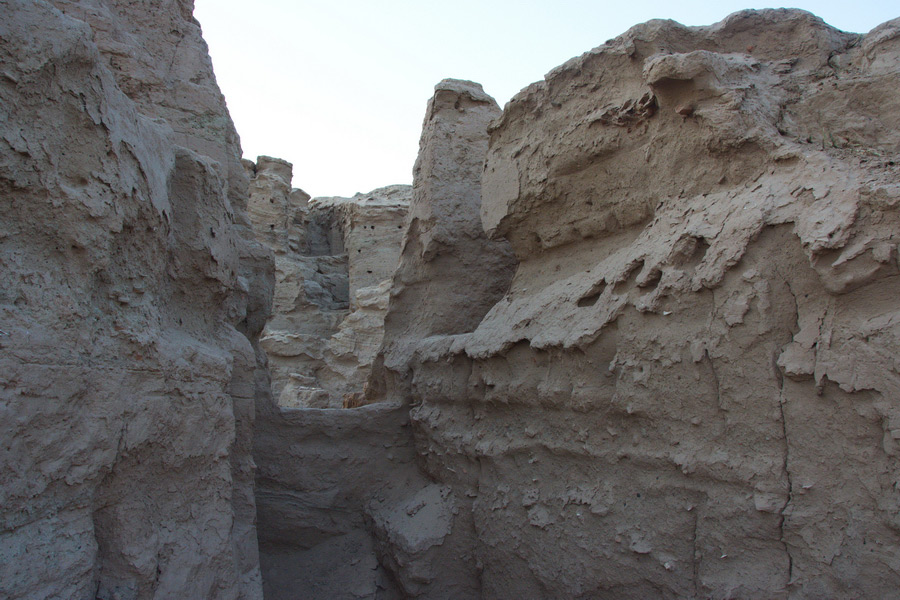遗产数据库
卡姆佩尔特佩 (Kampyrtepa) 古城遗址
卡姆佩尔特佩 (Kampyrtepa) 古城遗址
卡姆佩尔特佩古城遗址[4]位于阿姆河右岸台地的山丘上, 东南距乌兹别克斯坦苏尔汉河州铁尔梅兹市30公里。遗址东为自然峡谷, 南为阿姆河谷地。
遗址为一古城, 平面近似椭圆形, 东西长260、南北宽160米, 面积约4万平方米。北侧、东侧被城墙环绕, 城墙以土坯垒砌, 厚约5米。城墙外围每隔一段距离有一凸出马面, 东北城角有圆形角墩。墙外有护城河。城南侧为深达19米的断崖, 没有城墙 (封三) 。
图二四卡姆佩尔特佩古城遗址希腊化时期遗迹 下载原图
图二五卡姆佩尔特佩古城遗址贵霜时期遗迹 下载原图
图二六陶塑人像 下载原图
图二七陶高足杯 下载原图
图二八陶高足杯 下载原图
图二九石器盖上的镶嵌 下载原图
图三〇陶钵 下载原图
城址大部分已经过发掘, 经过地层学和年代学研究, 发现该遗址可分为三期:第一期为希腊化时期, 包括塞琉古和希腊—巴克特里亚两个阶段, 时代为公元前4世纪晚期~前2世纪中期;第二期为月氏时期, 即前贵霜时期, 时代为公元前2世纪中期~1世纪早期;第三期为早期贵霜和贵霜时期, 时代为公元1世纪早期~2世纪中期。
城址内部可分为设防堡垒、居住区和不设防的“郊区”三大部分, 其中希腊化时期的遗迹主要包括遗址南侧未被城墙包围的堡垒和成排的房屋 (图二四) 。堡垒长约80米, 具有大而厚并且经过加固的外墙体, 有明显的设防意味, 其内有6个住宅区和1个公共设施。
住宅区的房屋均用土坯垒砌, 有的经过多次重建。房屋共有100多间, 基本是以家庭为单位分布, 每个家庭住宅都包括多个不同功能的房间, 有寝室、厨房、储藏室等, 还有独立的院落。其中一个大型住宅包括超过20间的房屋。住宅区之间以狭窄的街道相隔, 街道的交叉处通常都有商店或摊位的遗迹。而城堡西侧的公共建筑设施可能为一座琐罗亚斯德教的神庙, 结构较复杂, 由4个大小不一的房间和走廊组成, 其中主室内有祭坛和燃火痕迹。
希腊化时期的文化层和遗迹中出土有较丰富的遗物, 包括陶器、雕塑、石器、青铜器和钱币、壁画等, 其中陶器如高足杯等具有典型的希腊文化特征, 钱币也是希腊式的银币 (图二六~二九) 。
公元前2世纪中叶之后, 该遗址进入前贵霜时期。这一时期的遗迹分布范围大致与上一时期重合, 但城堡已遭废弃, 只是依托城堡的墙体建立了若干功能性的小房屋。这一时期的出土物较少。
从公元1世纪开始, 该遗址进入了贵霜时期, 并一直延续到贵霜王迦腻色迦统治的时代。遗址北部的城墙和居住区即是属于这一时期的遗迹, 居住区也被道路分割成数个街区, 每个街区均有大量相连的以土坯垒砌的房屋遗迹 (图二五) 。可见这一时期遗址的规模开始扩大, 人口也在增加。属于这一时期的遗物包括陶器、佛像和贵霜钱币 (图三〇) 。
30 km downstream from Termez, Kampyr Tepe was a Macedonian town in Bactria, just north of the river Oxus, founded by Alexander the Great. It might have been the place were he crossed the river, and it was probably called Alexandria on the Oxus; Ai Khanum on the Afghan-Tajik border is also a contender for the title, but evidence nowadays tilts the scales towards Kampyr Tepe.
Founded in the 4th century BCE, Macedonian, Graeco-Bactrian, and Kushan finds point to a Golden Age in the first and second centuries CE, under the rule of Kanishka the Great. Afterwards, the city was abandoned and never returned to after being flooded by the Oxus, thus revealing much about early city planning to archaeologists.
For a long time, the site was off-limits due to its proximity to the Afghan border. Nowadays, you can visit again to see what remains of this famed city. Visitors often rate Kampyr Tepe the most impressive archaeological site in the south of Uzbekistan. The 2500-year-old ruins consist of Hellenistic style fortifications, a residential area, trade suburbs and a port.
1972年苏联考古学家在铁尔梅兹以西30公里的卡姆皮尔秋别(Kampyr-Tepe,又常拼写为Kampir-Tepe,这个地方又被称为Kafir-Qala,意思是“异教徒城堡”),发现一处有浓郁贵霜文化色彩的古城遗址。古城位于阿姆河北岸的黄土高台上,南北都是陡峭险峻的深沟,北边有城墙遗迹。研究者如E.V.Rtveladze立即把这处遗址与米诺尔斯基所说的Pardagvi古客舍城联系起来。1979年对这个遗址进行了试掘,1982年开始全面发掘,到苏联解体之前,该古城遗址绝大部分都已完成发掘和研究,考古学家认定这是一座贵霜全盛时期的渡口城市,就是Hafiz-i Abru所记的Pardagvi古客舍城。
我们在铁尔梅兹的第四天,来到卡姆皮尔秋别。第一眼就被那复原后的北城墙所震撼,城墙上多至两排的、贵霜特有的箭簇形窗户(或射击孔)给人深刻印象。进入城墙,烈日下难分形状的黄土建筑,干燥又寂静的远近地貌,满地码放、用以复原古城的新造土砖,让人很难想象这里曾是古代巴克特里亚地区最繁荣、最古老的渡口。古城遗址由城区、城堡、城外居民区、墓葬区和宗教祭祀区组成。我们在城堡区坍塌叠压的断裂带,看到许多深埋入土的巨大陶瓮。这种大陶瓮在某些大概是库房的房间整齐排列,不知道用以盛葡萄酒还是盛谷物。
客舍城遗址巨大的陶瓮
站在城堡顶部平台上,向南俯瞰阿姆河河谷,绿色田野如一面布幔向东向西缓缓伸展,包裹住南边那一缕灰蓝色的阿姆河。由于阿姆河河道明显向南摆动,原河道所在靠近古城遗址的地带成了肥沃的农田。可以说,这个遗址已远离阿姆河,完全不适合当作渡口了。不知道这一变化始于何时,也不知道这是不是该渡口失去主渡口地位的原因。研究者认为,这个渡口的最早年代可能比青铜时代还要早,而古城遗址则属于公元前4世纪至公元前1世纪的建筑遗存,全盛期在贵霜帝国的迦腻色伽一世之时。这意味着在漫长的时期内,此地都是本地区最主要的渡口。由前引Hafiz-i Abru的那段话来看,在依托先知岛的铁尔梅兹古城渡口崛起的过程中,这个“客舍城”古渡口仍在使用,两者间存在明显的竞争关系。可以肯定的一点是,正是由于在竞争中表现出越来越明显的优势,才有了铁尔梅兹古城的繁荣,以及客舍城的衰落与废弃。
Kampyr-Tepe (Alexandria of Oxia), vicinity of Termez
Kampyr-Tepe is an ancient settlement in southern Uzbekistan, located 30 kilometers from the city of Termez. At 2,400 years old, it is one of the oldest archaeological sites in Central Asia. Founded during the Hellenistic period, Kampyr-Tepe played a key role in fostering trade and cultural exchange across the region. Its fortifications, residential quarters, and religious structures showcase the influence of Greco-Bactrian architecture and bear witness to the high cultural standards of the era.
The city emerged as a port on the Amu Darya River, known in antiquity as the Oxus. Excavations have uncovered an extensive system of defensive walls, workshops for artisans, and storage facilities for goods - all confirming the site’s significance as a major commercial and administrative hub. Many scholars believe Kampyr-Tepe to be the legendary Alexandria on the Oxus, founded by Alexander the Great during his Central Asian campaigns.
History
Kampyr-Tepe (Alexandria of Oxia), vicinity of TermezKampyr-Tepe (Alexandria of Oxia), vicinity of Termez
The history of Kampyr-Tepe begins in the late IV century BC, when a small port outpost was established on a broad loess terrace. Alongside residential dwellings, the early settlement included ceramic workshops and a mint. The construction of a fortified citadel, complete with high walls and watchtowers, marked the start of the 1st century AD. The stronghold served as a vital trading post on the route linking Afrasiab, the capital of Sogdiana, with the southern territories of Bactria. This route crossed a strategically important point within the settlement, allowing it to control both regional and international trade flows.
The city flourished in the first third of the II century AD, under the rule of the Kushan king Kanishka I (103–125 AD). At its height, the fortress became a thriving center of commerce, religion, and craftsmanship. In the early medieval period, however, a new river crossing was established 700 meters east, at the fortified post of Shurobkurgan, near the mouth of the Karasu River. As trade and transport routes shifted, Kampyr-Tepe gradually lost its importance and was eventually abandoned.
The ruins were discovered in 1972 by archaeologist Edvard Rtveladze, who spent decades studying the site. His research led to the conclusion that Kampyr-Tepe was indeed founded by Alexander the Great during his campaigns in 329–327 BC.
Finds
Archaeological excavations at Kampyr-Tepe have yielded a wealth of artifacts that illuminate the city's economic, cultural, and religious life. Among the most significant discoveries are ceramics, coins, weapons, jewelry, and architectural fragments.
The coin hoards include both local Kushan drachmas and coins of Greco-Bactrian rulers, attesting to the settlement's integration into international trade networks. Excavated pottery includes locally made wares as well as imports from distant regions. Particularly valuable are birch bark manuscripts inscribed in the Kharosthi script and fragments of texts in the Bactrian language.
Notable religious artifacts include statuettes of deities, altars, and architectural ornaments featuring symbolic motifs. These items point to a rich tapestry of spiritual practices, with evidence suggesting that Zoroastrianism, Buddhism, and other local beliefs coexisted at the site.
Infrastructure
A dedicated tourist area has been developed near the Kampyr-Tepe site. Paved roads now lead to the settlement, offering convenient access for visitors. Infrastructure includes ample parking space designed to accommodate tour buses.




